Financial Analysis and Accounting Assignment - Holmes Institute
VerifiedAdded on 2022/11/26
|7
|1323
|145
Homework Assignment
AI Summary
This assignment solution for the Accounting for Business course (HC1010) involves a detailed analysis of financial statements and key financial ratios. Part A focuses on calculating and interpreting ratios such as the current ratio, quick ratio, accounts receivable turnover, and inventory turnover to assess short-term liquidity and efficiency. The analysis compares financial performance between 2018 and 2019, highlighting improvements and areas of concern. Part B delves into the definitions of income and revenue, classifying various financial items (software sales, interest, discounts, share issues) correctly. Part C applies financial analysis to a loan scenario, comparing ABC and XYZ companies based on their current ratios and liabilities to determine which company is a better candidate for a loan, and assessing the valuation of the two companies based on their liabilities and asset base. The solution references several accounting and finance textbooks and standards like AASB.
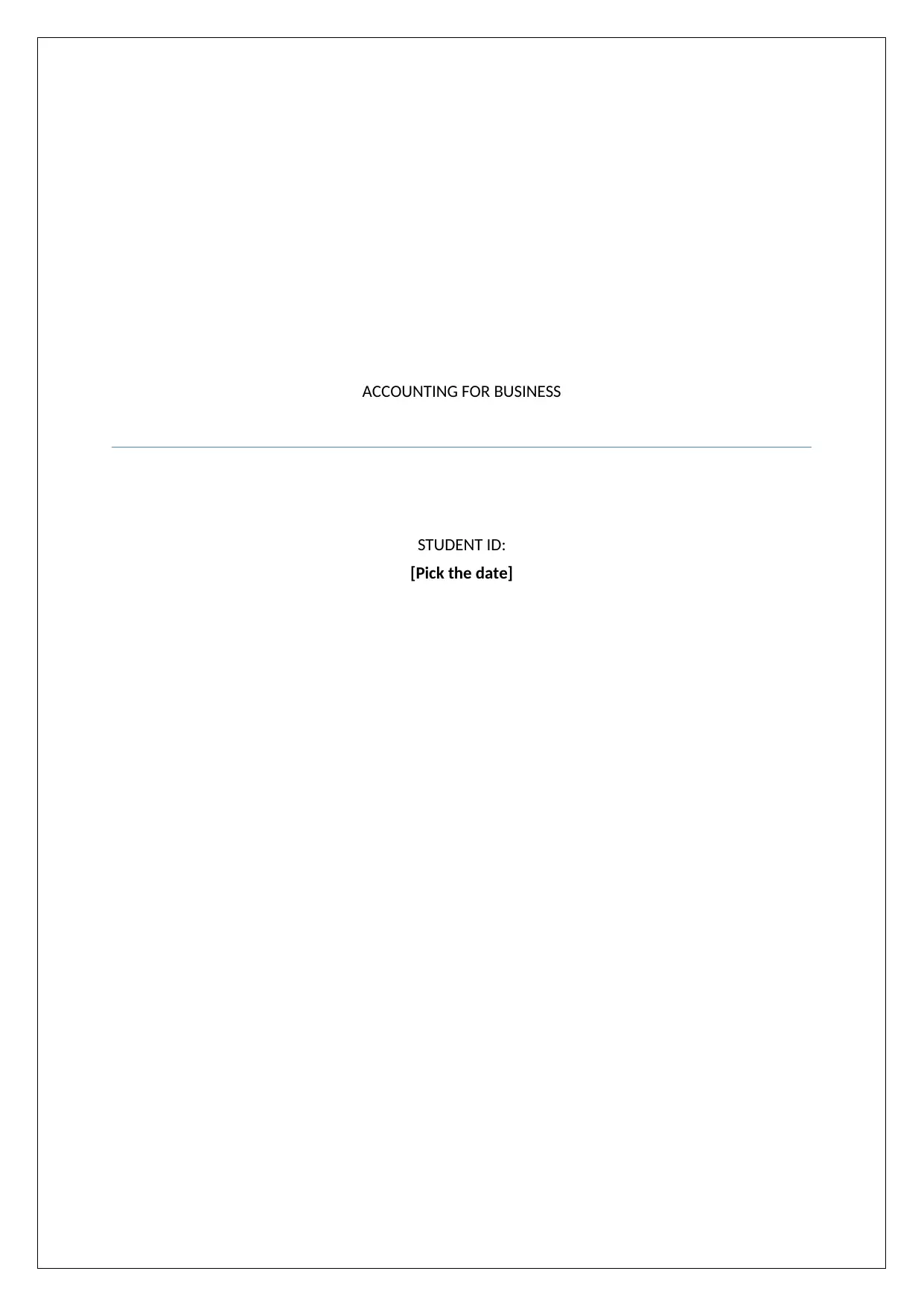
ACCOUNTING FOR BUSINESS
STUDENT ID:
[Pick the date]
STUDENT ID:
[Pick the date]
Paraphrase This Document
Need a fresh take? Get an instant paraphrase of this document with our AI Paraphraser
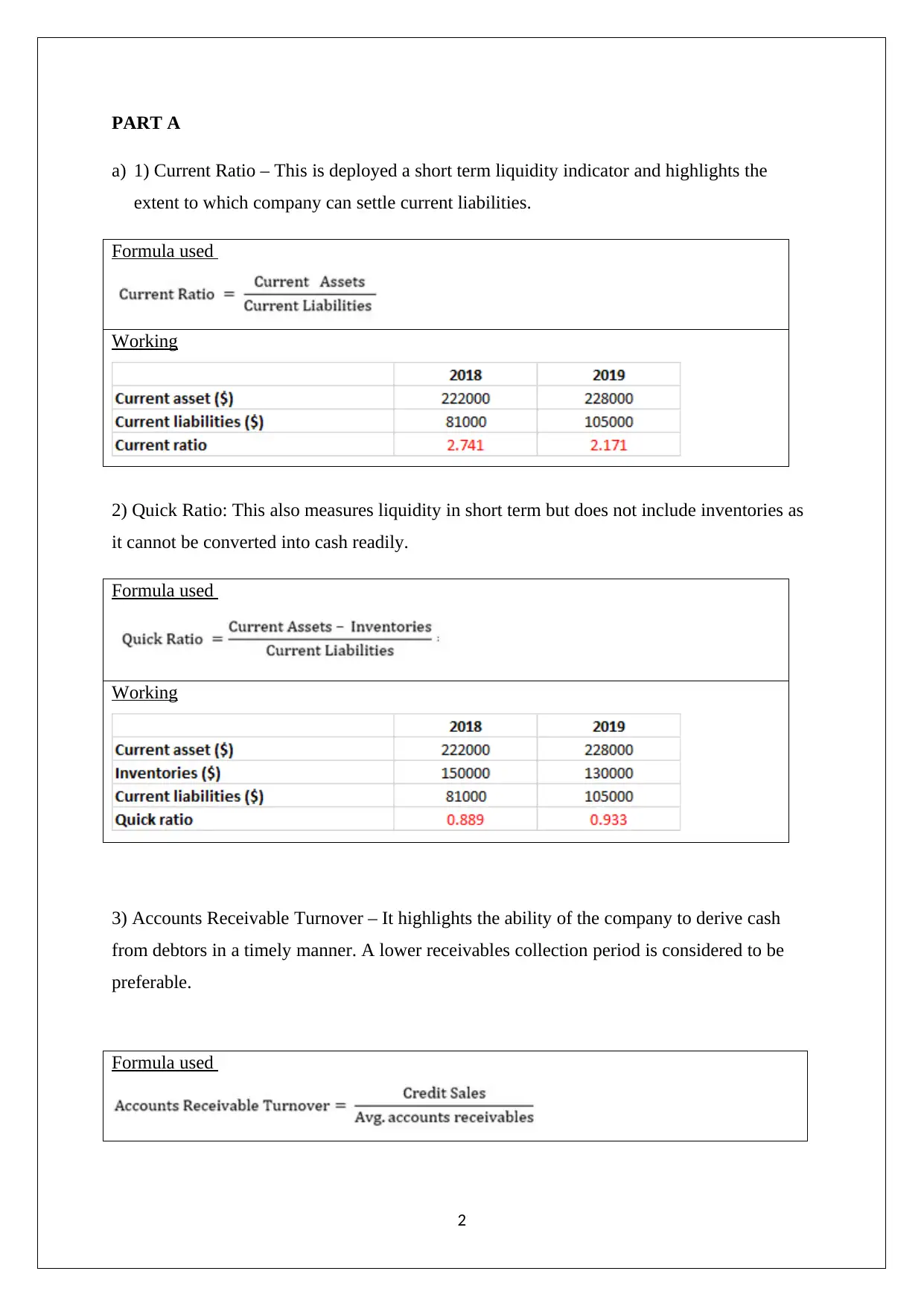
PART A
a) 1) Current Ratio – This is deployed a short term liquidity indicator and highlights the
extent to which company can settle current liabilities.
Formula used
Working
2) Quick Ratio: This also measures liquidity in short term but does not include inventories as
it cannot be converted into cash readily.
Formula used
Working
3) Accounts Receivable Turnover – It highlights the ability of the company to derive cash
from debtors in a timely manner. A lower receivables collection period is considered to be
preferable.
Formula used
2
a) 1) Current Ratio – This is deployed a short term liquidity indicator and highlights the
extent to which company can settle current liabilities.
Formula used
Working
2) Quick Ratio: This also measures liquidity in short term but does not include inventories as
it cannot be converted into cash readily.
Formula used
Working
3) Accounts Receivable Turnover – It highlights the ability of the company to derive cash
from debtors in a timely manner. A lower receivables collection period is considered to be
preferable.
Formula used
2
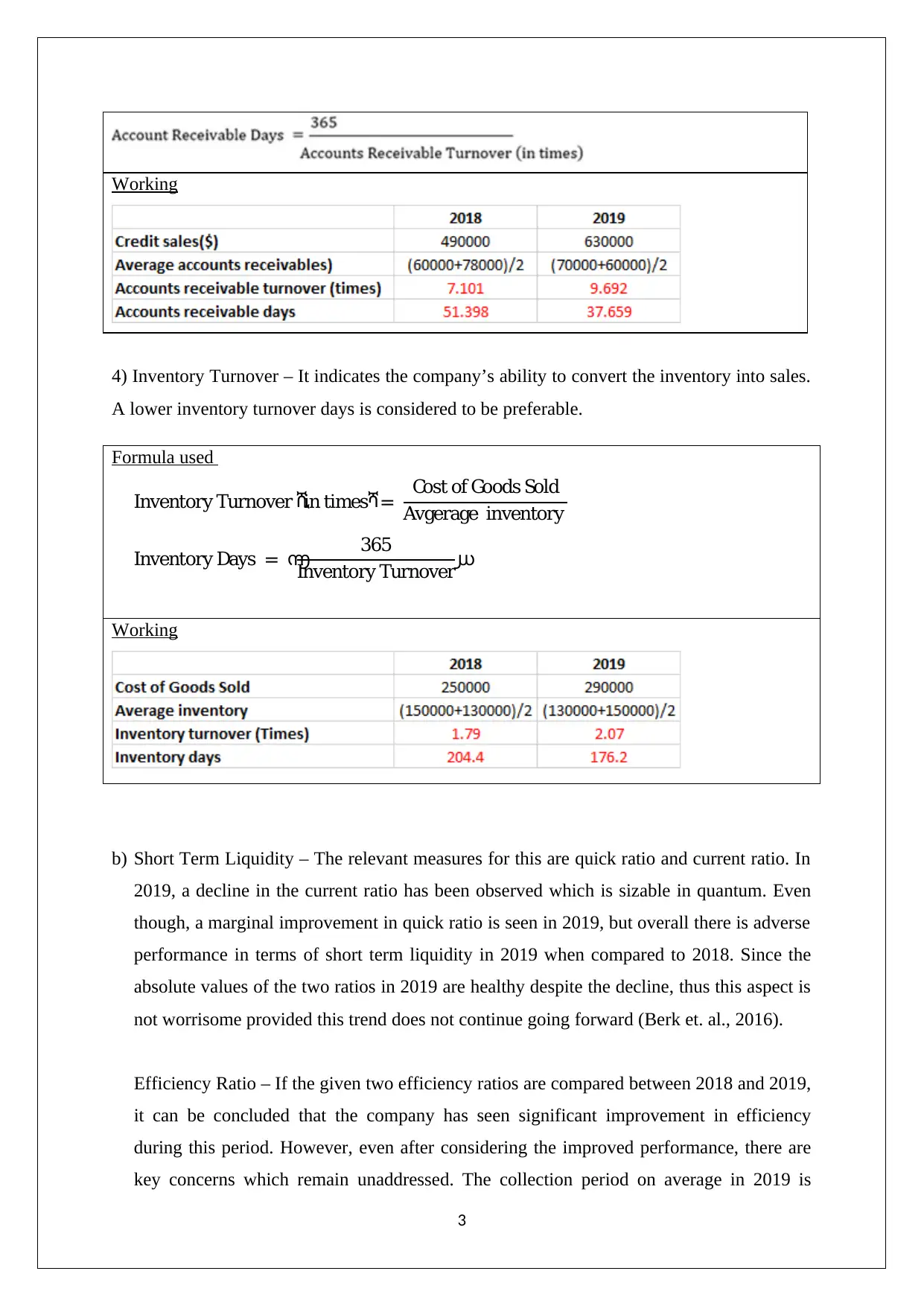
Working
4) Inventory Turnover – It indicates the company’s ability to convert the inventory into sales.
A lower inventory turnover days is considered to be preferable.
Formula used
Inventory Turnover ሺin timesሻ= Cost of Goods Sold
Avgerage inventory
Inventory Days = ൬ 365
Inventory Turnover൰
Working
b) Short Term Liquidity – The relevant measures for this are quick ratio and current ratio. In
2019, a decline in the current ratio has been observed which is sizable in quantum. Even
though, a marginal improvement in quick ratio is seen in 2019, but overall there is adverse
performance in terms of short term liquidity in 2019 when compared to 2018. Since the
absolute values of the two ratios in 2019 are healthy despite the decline, thus this aspect is
not worrisome provided this trend does not continue going forward (Berk et. al., 2016).
Efficiency Ratio – If the given two efficiency ratios are compared between 2018 and 2019,
it can be concluded that the company has seen significant improvement in efficiency
during this period. However, even after considering the improved performance, there are
key concerns which remain unaddressed. The collection period on average in 2019 is
3
4) Inventory Turnover – It indicates the company’s ability to convert the inventory into sales.
A lower inventory turnover days is considered to be preferable.
Formula used
Inventory Turnover ሺin timesሻ= Cost of Goods Sold
Avgerage inventory
Inventory Days = ൬ 365
Inventory Turnover൰
Working
b) Short Term Liquidity – The relevant measures for this are quick ratio and current ratio. In
2019, a decline in the current ratio has been observed which is sizable in quantum. Even
though, a marginal improvement in quick ratio is seen in 2019, but overall there is adverse
performance in terms of short term liquidity in 2019 when compared to 2018. Since the
absolute values of the two ratios in 2019 are healthy despite the decline, thus this aspect is
not worrisome provided this trend does not continue going forward (Berk et. al., 2016).
Efficiency Ratio – If the given two efficiency ratios are compared between 2018 and 2019,
it can be concluded that the company has seen significant improvement in efficiency
during this period. However, even after considering the improved performance, there are
key concerns which remain unaddressed. The collection period on average in 2019 is
3
⊘ This is a preview!⊘
Do you want full access?
Subscribe today to unlock all pages.

Trusted by 1+ million students worldwide
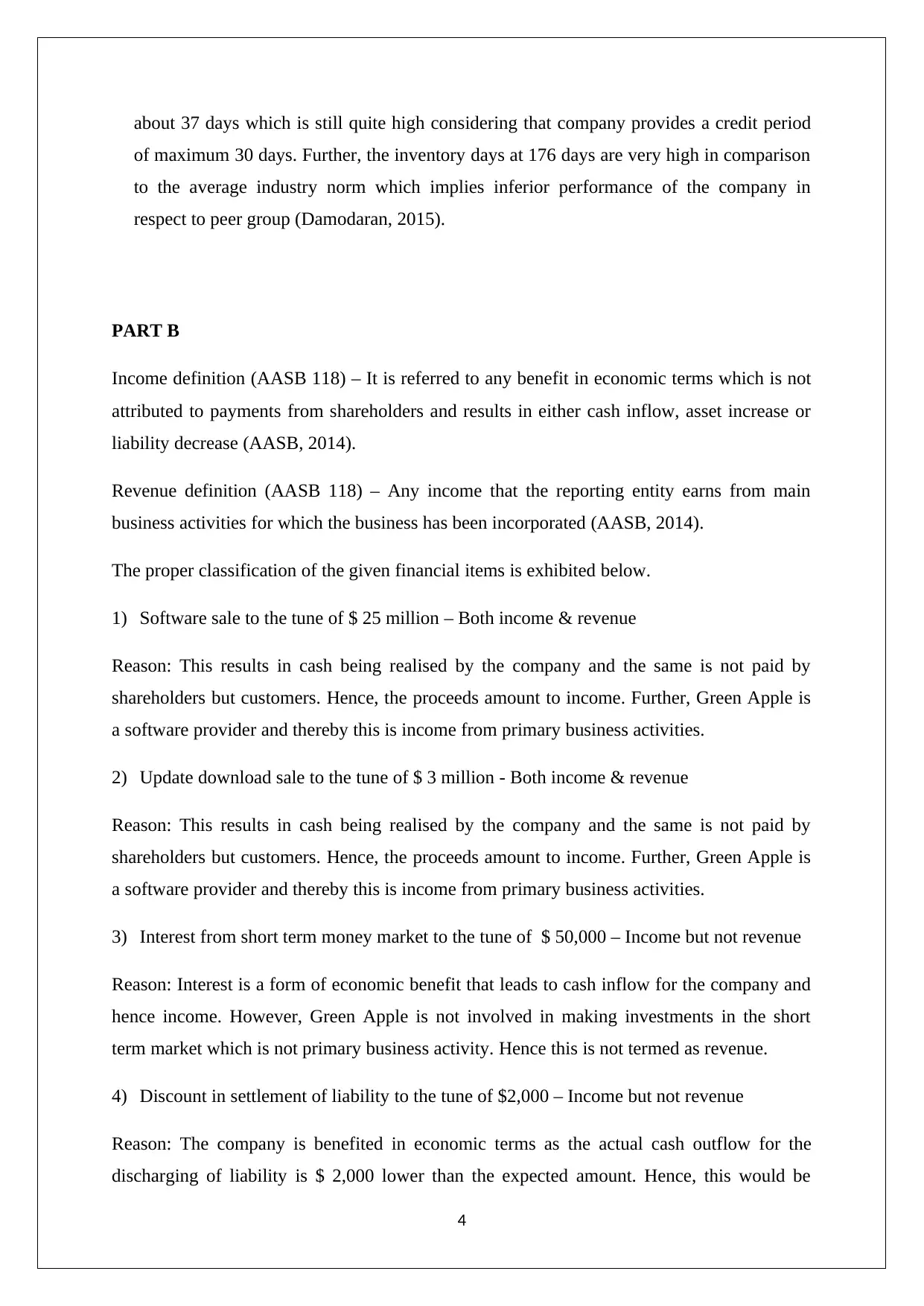
about 37 days which is still quite high considering that company provides a credit period
of maximum 30 days. Further, the inventory days at 176 days are very high in comparison
to the average industry norm which implies inferior performance of the company in
respect to peer group (Damodaran, 2015).
PART B
Income definition (AASB 118) – It is referred to any benefit in economic terms which is not
attributed to payments from shareholders and results in either cash inflow, asset increase or
liability decrease (AASB, 2014).
Revenue definition (AASB 118) – Any income that the reporting entity earns from main
business activities for which the business has been incorporated (AASB, 2014).
The proper classification of the given financial items is exhibited below.
1) Software sale to the tune of $ 25 million – Both income & revenue
Reason: This results in cash being realised by the company and the same is not paid by
shareholders but customers. Hence, the proceeds amount to income. Further, Green Apple is
a software provider and thereby this is income from primary business activities.
2) Update download sale to the tune of $ 3 million - Both income & revenue
Reason: This results in cash being realised by the company and the same is not paid by
shareholders but customers. Hence, the proceeds amount to income. Further, Green Apple is
a software provider and thereby this is income from primary business activities.
3) Interest from short term money market to the tune of $ 50,000 – Income but not revenue
Reason: Interest is a form of economic benefit that leads to cash inflow for the company and
hence income. However, Green Apple is not involved in making investments in the short
term market which is not primary business activity. Hence this is not termed as revenue.
4) Discount in settlement of liability to the tune of $2,000 – Income but not revenue
Reason: The company is benefited in economic terms as the actual cash outflow for the
discharging of liability is $ 2,000 lower than the expected amount. Hence, this would be
4
of maximum 30 days. Further, the inventory days at 176 days are very high in comparison
to the average industry norm which implies inferior performance of the company in
respect to peer group (Damodaran, 2015).
PART B
Income definition (AASB 118) – It is referred to any benefit in economic terms which is not
attributed to payments from shareholders and results in either cash inflow, asset increase or
liability decrease (AASB, 2014).
Revenue definition (AASB 118) – Any income that the reporting entity earns from main
business activities for which the business has been incorporated (AASB, 2014).
The proper classification of the given financial items is exhibited below.
1) Software sale to the tune of $ 25 million – Both income & revenue
Reason: This results in cash being realised by the company and the same is not paid by
shareholders but customers. Hence, the proceeds amount to income. Further, Green Apple is
a software provider and thereby this is income from primary business activities.
2) Update download sale to the tune of $ 3 million - Both income & revenue
Reason: This results in cash being realised by the company and the same is not paid by
shareholders but customers. Hence, the proceeds amount to income. Further, Green Apple is
a software provider and thereby this is income from primary business activities.
3) Interest from short term money market to the tune of $ 50,000 – Income but not revenue
Reason: Interest is a form of economic benefit that leads to cash inflow for the company and
hence income. However, Green Apple is not involved in making investments in the short
term market which is not primary business activity. Hence this is not termed as revenue.
4) Discount in settlement of liability to the tune of $2,000 – Income but not revenue
Reason: The company is benefited in economic terms as the actual cash outflow for the
discharging of liability is $ 2,000 lower than the expected amount. Hence, this would be
4
Paraphrase This Document
Need a fresh take? Get an instant paraphrase of this document with our AI Paraphraser
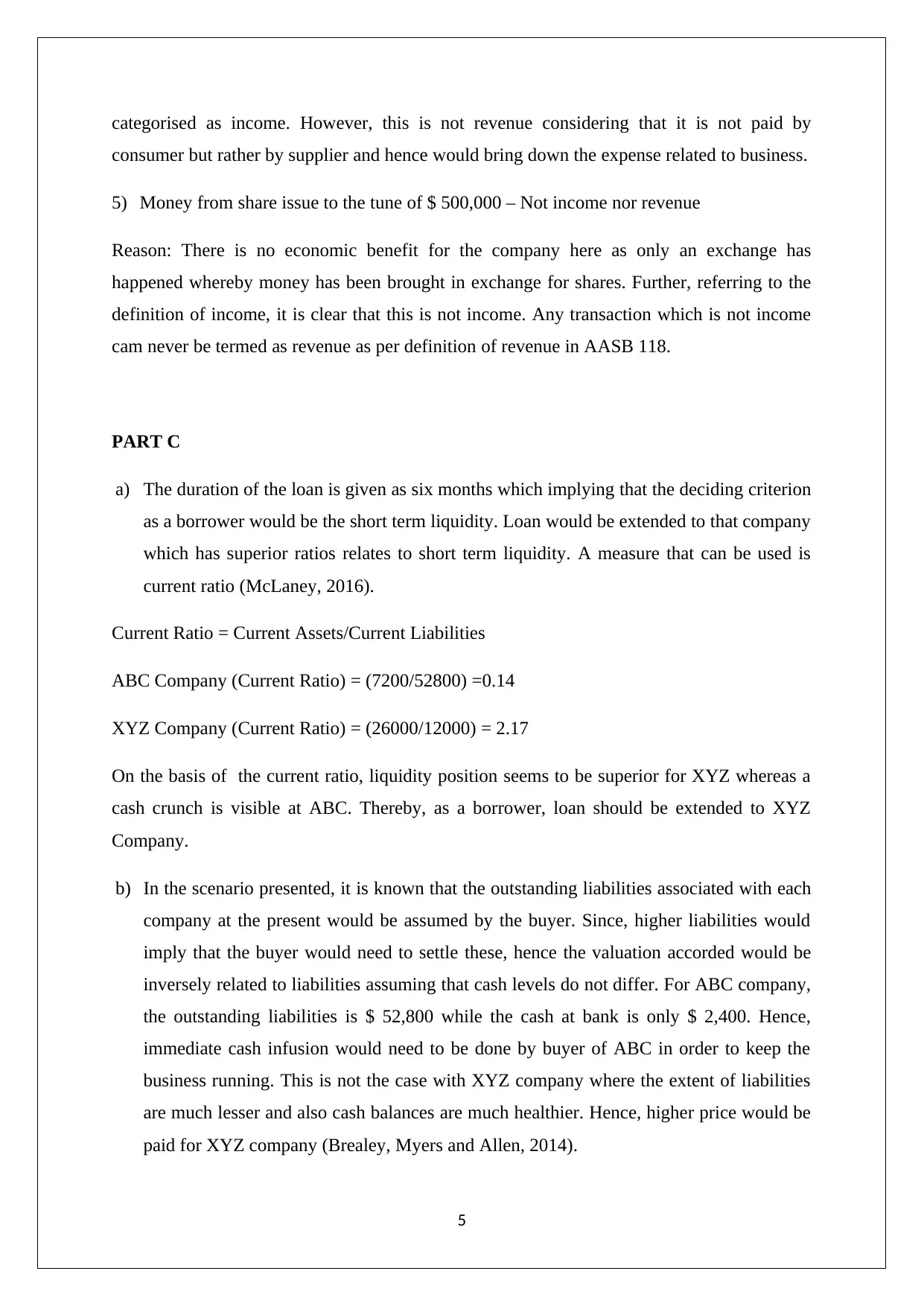
categorised as income. However, this is not revenue considering that it is not paid by
consumer but rather by supplier and hence would bring down the expense related to business.
5) Money from share issue to the tune of $ 500,000 – Not income nor revenue
Reason: There is no economic benefit for the company here as only an exchange has
happened whereby money has been brought in exchange for shares. Further, referring to the
definition of income, it is clear that this is not income. Any transaction which is not income
cam never be termed as revenue as per definition of revenue in AASB 118.
PART C
a) The duration of the loan is given as six months which implying that the deciding criterion
as a borrower would be the short term liquidity. Loan would be extended to that company
which has superior ratios relates to short term liquidity. A measure that can be used is
current ratio (McLaney, 2016).
Current Ratio = Current Assets/Current Liabilities
ABC Company (Current Ratio) = (7200/52800) =0.14
XYZ Company (Current Ratio) = (26000/12000) = 2.17
On the basis of the current ratio, liquidity position seems to be superior for XYZ whereas a
cash crunch is visible at ABC. Thereby, as a borrower, loan should be extended to XYZ
Company.
b) In the scenario presented, it is known that the outstanding liabilities associated with each
company at the present would be assumed by the buyer. Since, higher liabilities would
imply that the buyer would need to settle these, hence the valuation accorded would be
inversely related to liabilities assuming that cash levels do not differ. For ABC company,
the outstanding liabilities is $ 52,800 while the cash at bank is only $ 2,400. Hence,
immediate cash infusion would need to be done by buyer of ABC in order to keep the
business running. This is not the case with XYZ company where the extent of liabilities
are much lesser and also cash balances are much healthier. Hence, higher price would be
paid for XYZ company (Brealey, Myers and Allen, 2014).
5
consumer but rather by supplier and hence would bring down the expense related to business.
5) Money from share issue to the tune of $ 500,000 – Not income nor revenue
Reason: There is no economic benefit for the company here as only an exchange has
happened whereby money has been brought in exchange for shares. Further, referring to the
definition of income, it is clear that this is not income. Any transaction which is not income
cam never be termed as revenue as per definition of revenue in AASB 118.
PART C
a) The duration of the loan is given as six months which implying that the deciding criterion
as a borrower would be the short term liquidity. Loan would be extended to that company
which has superior ratios relates to short term liquidity. A measure that can be used is
current ratio (McLaney, 2016).
Current Ratio = Current Assets/Current Liabilities
ABC Company (Current Ratio) = (7200/52800) =0.14
XYZ Company (Current Ratio) = (26000/12000) = 2.17
On the basis of the current ratio, liquidity position seems to be superior for XYZ whereas a
cash crunch is visible at ABC. Thereby, as a borrower, loan should be extended to XYZ
Company.
b) In the scenario presented, it is known that the outstanding liabilities associated with each
company at the present would be assumed by the buyer. Since, higher liabilities would
imply that the buyer would need to settle these, hence the valuation accorded would be
inversely related to liabilities assuming that cash levels do not differ. For ABC company,
the outstanding liabilities is $ 52,800 while the cash at bank is only $ 2,400. Hence,
immediate cash infusion would need to be done by buyer of ABC in order to keep the
business running. This is not the case with XYZ company where the extent of liabilities
are much lesser and also cash balances are much healthier. Hence, higher price would be
paid for XYZ company (Brealey, Myers and Allen, 2014).
5
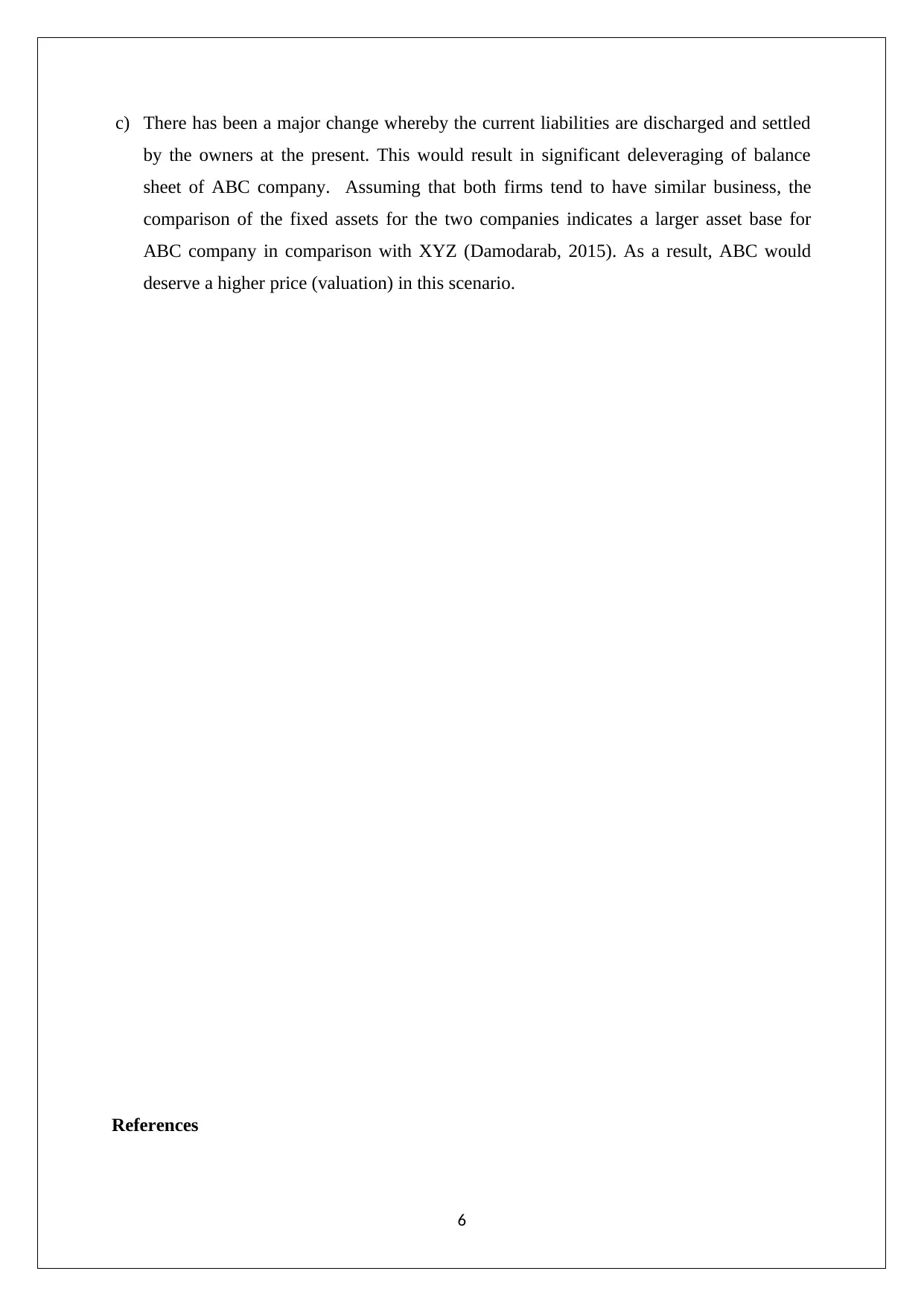
c) There has been a major change whereby the current liabilities are discharged and settled
by the owners at the present. This would result in significant deleveraging of balance
sheet of ABC company. Assuming that both firms tend to have similar business, the
comparison of the fixed assets for the two companies indicates a larger asset base for
ABC company in comparison with XYZ (Damodarab, 2015). As a result, ABC would
deserve a higher price (valuation) in this scenario.
References
6
by the owners at the present. This would result in significant deleveraging of balance
sheet of ABC company. Assuming that both firms tend to have similar business, the
comparison of the fixed assets for the two companies indicates a larger asset base for
ABC company in comparison with XYZ (Damodarab, 2015). As a result, ABC would
deserve a higher price (valuation) in this scenario.
References
6
⊘ This is a preview!⊘
Do you want full access?
Subscribe today to unlock all pages.

Trusted by 1+ million students worldwide
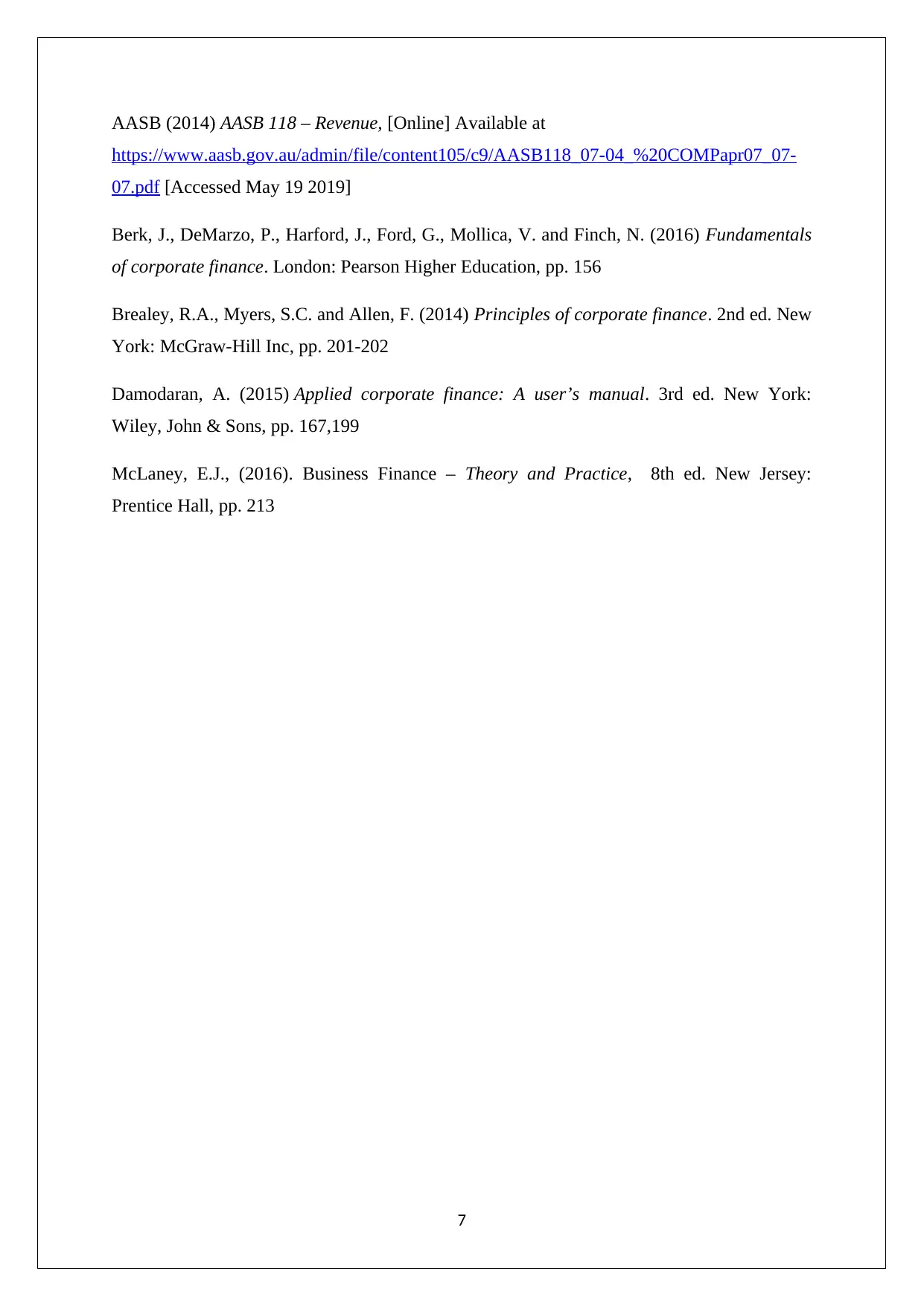
AASB (2014) AASB 118 – Revenue, [Online] Available at
https://www.aasb.gov.au/admin/file/content105/c9/AASB118_07-04_%20COMPapr07_07-
07.pdf [Accessed May 19 2019]
Berk, J., DeMarzo, P., Harford, J., Ford, G., Mollica, V. and Finch, N. (2016) Fundamentals
of corporate finance. London: Pearson Higher Education, pp. 156
Brealey, R.A., Myers, S.C. and Allen, F. (2014) Principles of corporate finance. 2nd ed. New
York: McGraw-Hill Inc, pp. 201-202
Damodaran, A. (2015) Applied corporate finance: A user’s manual. 3rd ed. New York:
Wiley, John & Sons, pp. 167,199
McLaney, E.J., (2016). Business Finance – Theory and Practice, 8th ed. New Jersey:
Prentice Hall, pp. 213
7
https://www.aasb.gov.au/admin/file/content105/c9/AASB118_07-04_%20COMPapr07_07-
07.pdf [Accessed May 19 2019]
Berk, J., DeMarzo, P., Harford, J., Ford, G., Mollica, V. and Finch, N. (2016) Fundamentals
of corporate finance. London: Pearson Higher Education, pp. 156
Brealey, R.A., Myers, S.C. and Allen, F. (2014) Principles of corporate finance. 2nd ed. New
York: McGraw-Hill Inc, pp. 201-202
Damodaran, A. (2015) Applied corporate finance: A user’s manual. 3rd ed. New York:
Wiley, John & Sons, pp. 167,199
McLaney, E.J., (2016). Business Finance – Theory and Practice, 8th ed. New Jersey:
Prentice Hall, pp. 213
7
1 out of 7
Related Documents
Your All-in-One AI-Powered Toolkit for Academic Success.
+13062052269
info@desklib.com
Available 24*7 on WhatsApp / Email
![[object Object]](/_next/static/media/star-bottom.7253800d.svg)
Unlock your academic potential
Copyright © 2020–2025 A2Z Services. All Rights Reserved. Developed and managed by ZUCOL.





